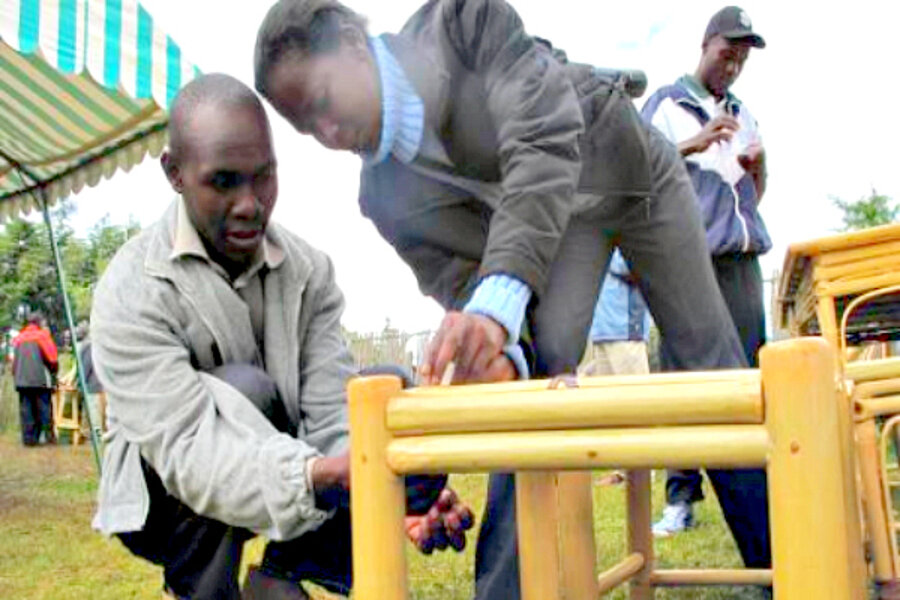Bamboo farming takes pressure off Kenya's forests
Loading...
| OLENGURUONE, Kenya
It is a chilly morning in Olenguruone village on the southern flank of the Rift Valley, but Gloria Chepng’etich is warming up to the task at hand.
Spread neatly on her workbench are bamboo splices that the 21-year-old will weave into floor mats over the next hour or so.
She will then pass the handicraft to her colleague, Zipporah Sirui, who will finish it with touches of dye, blending it into a colorful mix of orange, red, and gray.
A single mat fetches around $50, enough for each of them to buy cooking flour and save some money for a rainy day.
IN PICTURES: Sustaining the Environment
Beyond their work, Chepng’etich and Sirui have something else in common – both are internally displaced persons (IDPs). They were among the thousands of families evicted by the Kenyan government from the Mau forest complex in 2009, following pressure by environmentalists to rehabilitate the area.
The complex, which comprises 16 blocks of forest on the western side of the Rift Valley, is the largest indigenous forest in East Africa, generating and capturing rainfall that is a crucial resource for Kenya and beyond and a significant factor in mitigating the regional effects of climate change.
The eviction of forest residents won the government national and international praise, with officials arguing that it would reduce illegal harvesting of forest resources and create space for reforestation in the complex. But the social and economic costs were high.
“We were sent to the Kurbanyat IDP camp,” says Chepng’etich. “For a long time we relied on relief food, but the officials started stealing it.”
Destitute and desperate is how officials with the BamCraft Project found the two, and hundreds of other IDPs. The project is a partnership of Kenya Forestry Research Institute (KEFRI), the United Nations Industrial Development Organization, and the government of Japan.
Now the IDPs are finding a new way to make a living – without cutting trees – by turning to bamboo farming.
At the nearby Kapkempu IDP camp, Hudson Sang’ has been piecing together refined bamboo planks, which he will craft into furniture, selling a set for about $100.
“We have about an acre of land under bamboo,” says Sang’. “After harvesting [the bamboo] we make tables, chairs, floor mats, baskets, brooms, necklaces, sugar dishes, smoking pipes, and even wine cups.”
The land has been loaned to Sang’ and other IDPs by well-wishers while they await permanent resettlement by the government. As a result of the bamboo project, he no longer has to worry about the forest guards who enforce a ban that since 2000 has restricted the harvesting of forest resources from all government forests.
The legislation requires Kenyans to seek permission from local authorities before cutting down any tree from their farms, but it does not apply to bamboo since the plant is classified as a giant grass, officials say.
The legislation prompted the Kenya Forestry Research Institute to investigate opportunities offered by nontimber products and their potential to reduce pressure on forests, says Gordon Sigu, a research scientist working with the institution.
“Our research has shown that the grass … can supplement the rising demand for timber both at home and abroad,” Sigu said.
He said bamboo grows very quickly and a farmer does not need a big area of land to cultivate it.
Farmers in central Kenya are pleased with bamboo’s commercial value, and a growing number of them are adopting bamboo farming to supply industrial fiber, as well as planks for the construction sector.
“Before I came to know about its value I used bamboo for fencing,” says Moses Kamiri, a farmer in central Kenya. “But the last harvest fetched me enough money to feed my family and pay school fees.”
Kamiri now turns his bamboo harvest into finished products through a process set up by KEFRI for entrepreneurs.
The institute estimates that Kenya is home to 14 species of bamboo growing on some 150,000 hectares [370,000 acres] of land – more than a fifth of which lies within the Mau complex – but it says that a lot goes to waste because few people understand its commercial value.
According to KEFRI’s Rift Valley regional director, Joshua Cheboiywo, the country has the capacity to generate almost 25 million stems of bamboo per year without taking too much of the country’s water supply.
A 2010 government survey indicates that Kenya has a forest cover of 5.9 percent. The government hopes that the use of bamboo as an alternative timber resource, together with enforcement of the ban on logging in the Mau complex, will help the country make headway towards the target envisioned in the country’s constitution of 10 percent forest cover within the next 30 years.
• Kagondu Njagi is an environmental writer based in Nairobi. This article originally appeared at Alertnet, a humanitarian news site operated by the Thomson Reuters Foundation.
• Sign up to receive a weekly selection of practical and inspiring Change Agent articles by clicking here.







